PhysGaussian
Physics-Integrated 3D Gaussians for Generative Dynamics (CVPR 2024)
PhysGaussian - Physics-Integrated 3D Gaussians for Generative Dynamics
Tianyi Xie, Zeshun Zong, Yuxing Qiu, Xuan Li, Yutao Feng, Yin Yang, Chenfanfu Jiang
paper :
https://arxiv.org/abs/2311.12198
project website :
https://xpandora.github.io/PhysGaussian/
code :
https://github.com/XPandora/PhysGaussian
reference :
https://xoft.tistory.com/101
Contribution
-
Physics Simulation을3DGS에 결합 :- 3DGS에 부피, 질량, 속도 (Physics) property를 부여하여
3DGS의 covariance 및 rotation matrix가 시간에 따라 물리 법칙에 따라 변화 - MPM simulation 장점과 3DGS rendering 장점을 결합하여
unified simulation-rendering pipeline 제시
- 3DGS에 부피, 질량, 속도 (Physics) property를 부여하여
결과 영상이 재밌음!
Overview

- Step 1)
3DGS optimization
Anisotropic Loss를 추가하여 3DGS를 둥글둥글하게 만듦 - Step 2)
3DGS Internel Filling
Object 내부 공간을 3DGS로 채워서 continuum(연속체)로 만듦 - Step 3)
Physics Integration- Dynamics :
3DGS에 부피, 질량 부여하여
시간에 따라 Continuum Mechanics(연속체 역학)이라는 물리 법칙 따르도록 함 - Kinematics :
Gaussian Evolution, SH Transform을 통해
시간에 따른 물리적인 변화를 3DGS로 모델링
- Dynamics :
Backgrounds on Continuum Mechanics
- Conservation of Mass (질량 보존 법칙) :
시간 \(t\) 가 바뀌어도 infinitesimal region 내 질량은 항상 일정하게 유지된다!!
\(\int_{B_{\epsilon}^{t}} \rho (x, t) = \int_{B_{\epsilon}^{0}} \rho (\phi^{-1}(x, t), 0)\)- \(B_{\epsilon}^{t}\) : infinitesimal region at \(t\)
- \(\rho(x, t)\) : density field at \(x, t\)
- \(x = \phi(x_{0}, t)\) : deformation map from \(x_{0}, 0\) to \(x, t\)
- Conservation of Momentum (운동량 보존 법칙) :
시간 \(t\) 가 바뀌어도 물질의 운동량은 변하지 않는다!!
운동량 변화량 : \(\rho(x, t) \overset{\cdot}{v}(x, t) = \nabla \cdot \sigma(x, t) + f^{ext}\)- \(\overset{\cdot}{v}(x, t)\) : 가속도 field at \(x, t\)
- \(\sigma = \frac{1}{det(F)}\frac{\partial \psi}{\partial F}F^{E}(F^{E})^{T}\) : Cauchy stress tensor (물체 내부에서 발생하는 응력)
where \(\psi(F)\) : hyperelastic energy density
where deformation field gradient \(F = F^{E} F^{P}\)- \(F^{E}\) : elastic part (탄성)
물체에 stress를 가해서 조직에 구조적인 변형이 발생한 후,
stress를 제거했을 때 원래 상태로 되돌아가는 성질 - \(F^{P}\) : plastic part (소성)
물체에 stress를 가해서 조직에 구조적인 변형이 발생한 후,
stress가 탄성 범위를 넘어가서
stress를 제거하더라도 원래 상태로 되돌아오지 않는 성질
- \(F^{E}\) : elastic part (탄성)
- \(f^{ext}\) : external force per unit volume
MPM (Material Point Method)
- 핵심 :
particle과 grid 간에 운동량이 상호작용하여
이 과정에서 질량과 운동량이 보존되어
simulation했을 때 현실과 비슷- Lagrangian Particle Domain :
particle의 위치, 질량, 운동량, 응력, 부피, 외력 등을 모델링하고
particle 별로 추적하여 update - Eulerian Grid Domain :
공간을 3D grid로 나누어서 grid를 통해 particle 이동
cell의 크기가 작아질수록 정확도는 올라가지만 연산속도는 느려짐
- Lagrangian Particle Domain :
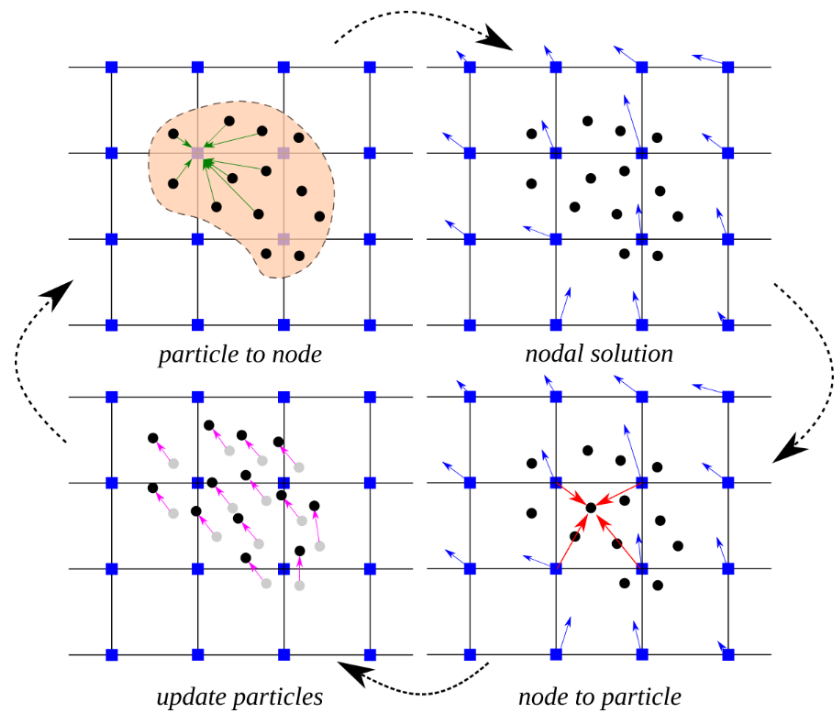
- Procedure :
- Particle to Node :
each particle의 물리량을 grid 상의 adjacent 8 nodes로 분배 - Nodal Solution :
집계된 힘을 이용해서 each node의 \(a = \frac{F}{m}\), \(v\) 를 update - Node to Particle :
each node의 \(a, v\) 를 particle로 전파 by weighted sum - Update Particles :
each particle의 \(a, v\) 이용해서 새로운 particle 위치 갱신
- Particle to Node :
실험 예시 : SIGGRAPH2018
Physics-Integrated 3DGS
그렇다면 어떻게 물리 법칙을 3DGS에 적용할까??
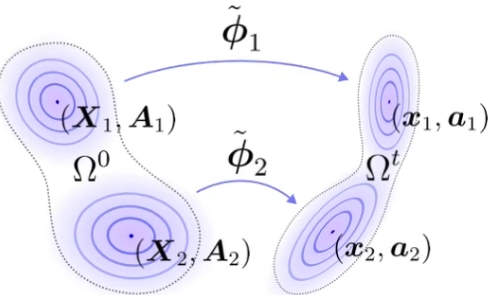
- 방법 1) deformation gradient \(F_{p}\) 로 approx.
- local affine transformation of deformation map \(\phi\) :
\(\tilde \phi (X, t) = x_{p} + F_{p} (X - X_{p})\)- \(X\) : arbitrary point
- \(X_{p}\) : particle \(p\) 의 initial point
- \(x_{p}\) : particle \(p\) 의 current point
- \(F_{p}\) : 점이 어떻게 이동하는지에 대한 deformation gradient matrix
(물리 법칙 적용)
- 3DGS position, covariance matrix 변화 :
By approx. deformation map,
\(x_{p}(t) = \tilde \phi (X_{p}, t)\)
\(\Sigma_{p}(t) = F_{p}(t) \Sigma_{p} F_{p}(t)^{T}\) - Gaussian 수식 변화 :
\(G_{p}(x, t) = e^{-\frac{1}{2}(x-x_{p})^{T}(F_{p}(t) \Sigma_{p} F_{p}(t)^{T})^{-1}(x-x_{p})}\) - grid 부피를 particle 수로 나누어서 각 particle 부피 \(V_{p}^{0}\) 를 초기화하고
이로써 각 particle(Gaussian)은 질량 \(m_{p} = \phi_{p} V_{p}\) 를 가지게 되고
MPM Simulation을 바탕으로 Gaussian이 물리 법칙을 따름 - 아래의 이유로 Physics와 3DGS의 결합은 자연스러움
- Gaussian itself가
Continuum의 discretized form으로 간주되므로
직접 simulation 가능 - 물리 법칙에 의해 변형된 Deformed Gaussian은
3DGS rasterization에 의해
직접 rendering 가능 - 따라서 WS2(What you see is What you simulate) 달성
- Gaussian itself가
- local affine transformation of deformation map \(\phi\) :
- 방법 2)
incremental update- deformation gradient \(F_{p}\) 에 의존하지 않고
Langrangian framework(MPM simulation)에 더 잘 맞는
Gaussian Kinematic(운동학) 방법 제시 - computational fluid dynamics (전산 유체 역학)에 따라
- covariance matrix :
covariance matrix는 discretize되어
\(\Sigma_{p}(t) = F_{p}(t) \Sigma_{p} F_{p}(t)^{T}\)
대신
\(\Sigma_{p}^{n+1} = \Sigma_{i}^{n} + \Delta t \overset{\cdot}{\Sigma_{p}^{n}} = \Sigma_{i}^{n} + \Delta t (\nabla v_{p} \Sigma_{p}^{n} + \Sigma_{p}^{n} \nabla v_{p}^{T})\) - rotation matrix :
마찬가지로 \(R_{p}^{0} = I\) 에서 출발해서 비슷하게 update 가능 - 즉,
covariance matrix와 rotation matrix가 물리 법칙을 따르면서 incrementally update되도록 설계!!
- covariance matrix :
- 위의 수식을 통해 deformation gradient \(F_{p}\) 를 직접 구하지 않더라도
Gaussian covariance를 \(t^{n}\) 에서 \(t^{n+1}\) 으로 incremental update 가능
- deformation gradient \(F_{p}\) 에 의존하지 않고
Orientation of SH
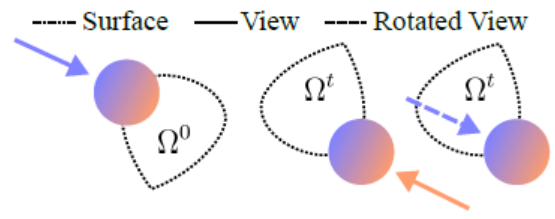
- SH는 view direction에 따른 color를 모델링하는, hard-coding되어 있는 함수이다
따라서 시간 \(t\) 에 따라 particle(Gaussian)이 rotate하면 색깔이 전혀 달라지므로
view direction에 particle(Gaussian)의 역회전을 적용- particle(Gaussian)의 회전 정보 :
surface orientation을 사용한 Point-NeRF 와 달리
방법 1)의 경우 polar decomposition을 통해 deformation gradient \(F_{p} = R_{p}S_{p}\) 에서 \(R_{p}\) 추출해서 사용
방법 2)의 경우 polar decomposition을 통해 \((I + \Delta t v_{p}) R_{p}^{n}\) 에서 \(R_{p}^{n+1}\) 추출해서 사용
- particle(Gaussian)의 회전 정보 :
Internal Filling
- recon. Gaussians는 surface 근처에 분포하는 경향이 있으므로
object의 내부 구조는 비어 있는 채로 surface에 가려져 있음
\(\rightarrow\)
object의 deformation이 클 경우 내부가 노출될 수도 있고
질량을 가지는 물리 법칙에 따르는 volumetric object으로 만들기 위해
비어 있는 내부 영역도 particles(Gaussians)로 채워야 함
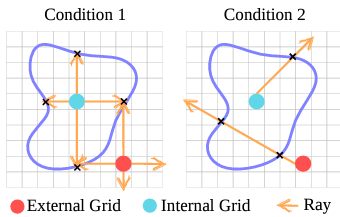
- Internal Filling :
- Step 1)
discretize
from continuous3D opacity field\(d(x) = \sum_{p} \sigma_{p} e^{-\frac{1}{2}(x-x_{p})^{T}\Sigma_{p}^{-1}(x-x_{p})}\)
into discrete 3D grid - Step 2)
low opacity(\(\sigma_{i} \lt \sigma_{th}\))를 가지는 grid에서
high opacity(\(\sigma_{j} \gt \sigma_{th}\))를 가지는 grid로
ray가 통과할 때
이를 intersection이라고 하자 - Step 3)
아래 두 가지 조건을 만족할 때 object 내부에 있다고 간주하고 3DGS 생성- Condition 1) :
3D grid 상에서 6 axes 방향으로 ray casting한 뒤
object 내부에 있는 grid의 경우 항상 surface와 intersect할 것이므로
intersection 개수가 6개인지 체크하여 candidate grids 선택 - Condition 2) :
candidate grids를 refine하기 위해
additional ray를 casting하여 intersection 개수 체크
- Condition 1) :
- Step 4)
object 내부에 채워 넣은 gaussian들도 3D 상에서 visualize할 필요가 있을 수 있음
internal-filled particle(Gaussian)의 경우
opacity \(\sigma_{p}\) 와 color \(C_{p}\) 는 closest Gaussian의 것을 물려받고
covariance matrix는 \(\text{diag}(r_{p}^{2}, r_{p}^{2}, r_{p}^{2})\) 으로 initialize
where \(r_{p}\) : particle radius from its volume \(V_{p}^{0} = \frac{4 \pi r_{p}^{3}}{3}\)
(본 논문의 저자는 시도하지 않았지만 internal filling을 위해 generative model을 사용하면 more realistic results 가능할 듯)
- Step 1)
Anisotropy Regularizer
- 3DGS가 너무 얇을 경우
large deformation일 때 Gaussian이 object surface의 바깥쪽으로 튀어나와
plush artifacts발생 가능
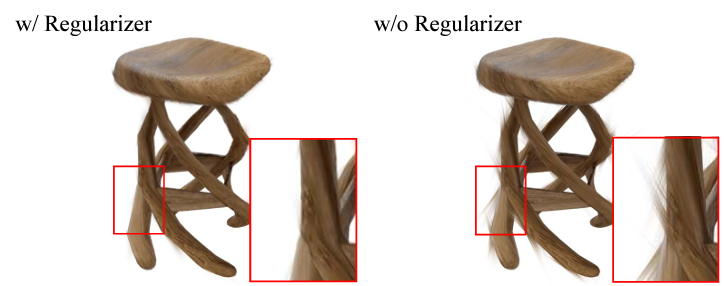
chair에 Twist deformation 가했을 때 생기는 plush artifacts
- \(L_{aniso} = \frac{1}{| P |} \sum_{p \in P} \text{max}(\frac{\text{max}(S_{p})}{\text{min}(S_{p})}, r) - r\)
where \(S_{p}\) : scale matrix of 3DGS- \(\frac{\text{max}(S_{p})}{\text{min}(S_{p})} \leq r\)
즉, 장축과 단축의 길이 비가 threshold \(r\) 을 넘지 않도록
3DGS를둥글둥글하게만듦
- \(\frac{\text{max}(S_{p})}{\text{min}(S_{p})} \leq r\)
Experiments
-
Dataset :
InstantNGP, NerfStudio, DroneDeployNeRF, \(\cdots\) -
Resource :
24-core 3.50GHz Intel i9-10920X machine with Nvidia RTX 3090 GPU - MPM Simulation :
- MPM :
SIGGRAPH2023 - simulation region :
simulation region을 manually 선택하여 \(2 \times 2 \times 2\) cube로 normalize한 뒤 3D dense crid로 discretize - particle :
controlled movement(흔들리는 여우 얼굴 등)를 보일 specific particles만 선택적으로 velocities 수정하고
나머지 particles는 물리 법칙을 따르는 natural motion
- MPM :
- Qualitative Results :
Video 를 보면
Simulation 할 때- Fox의 경우
물체의 원래 형태로 되돌아가는 Elasticity (탄성) 성질을 적용 - Plane의 경우
물체의 원래 형태로 되돌아가지 않는 Metal (금속) 성질을 적용 - Ruins의 경우
Sand 효과 (granular-level frictional effect based on Druker-Prager plastic model)를 적용 - Toast의 경우
MPM Simulation에 따라 큰 deformation이 발생하면 입자가 여러 그룹으로 분리되는 Fracture - Jam의 경우
Paste 효과 (non-Newtonian fluid based on Herschel Bulkley plastic model)를 적용
- Fox의 경우
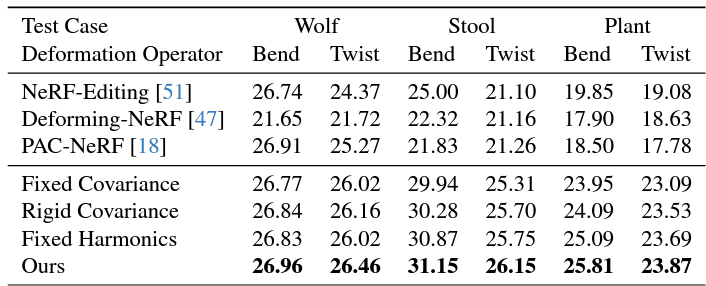
- Quantitative Results :
- deformation에 대한 GT를 만들기 위해
BlenderNeRF로 scene 합성한 뒤 lattice deformation tool로 Bend 및 Twist - 3가지 model과 비교
- NeRF-Editing :
- NeuS 로 추출한 surface mesh를 이용해서 NeRF 를 변형하는데,
surface recon.에 초점이 맞춰진 연구여서 volumetric simulation과 결합했을 때
rendering 퀄리티가 낮았음 - deformation이 extracted surface mesh와 dilated cage mesh의 정밀도에 의존하는데
mesh가 지나치게 크면 경계가 공백이 될 수 있음
- NeuS 로 추출한 surface mesh를 이용해서 NeRF 를 변형하는데,
- Deforming-NeRF :
- 고해상도 deformation cage mesh를 사용해서 변형하여 향상된 결과 보이지만
interpolation 과정에서 local detail을 filtering하면서 성능 낮아짐
- 고해상도 deformation cage mesh를 사용해서 변형하여 향상된 결과 보이지만
- PAC-NeRF :
- 단순한 object, texture를 표현하도록 디자인되어
particle representation을 통해 flexible하지만 rendering 퀄리티는 여전히 높지 않음
- 단순한 object, texture를 표현하도록 디자인되어
- NeRF-Editing :
- Ours :
zero-order info.(deformation map)와 first-order info.(deformation gradient)를 모두 활용하였으므로
deformation 후에도 높은 성능 보임 - Ablation Study :
- Fixed Covariance :
3DGS에 translation만 적용하여
covariance는 그대로 사용 - Rigid Covariance :
3DGS에 rigid transformation 적용하여
covariance를 수정하여 물리 법칙을 따르도록 - Fixed Harmonics :
SH에서 view direction을 rotate하지 않음
- Fixed Covariance :
- deformation에 대한 GT를 만들기 위해

논문에서 언급한 기법들을 적용하지 않을 경우 Gaussian이 surface를 제대로 덮지 않아 artifacts 발생
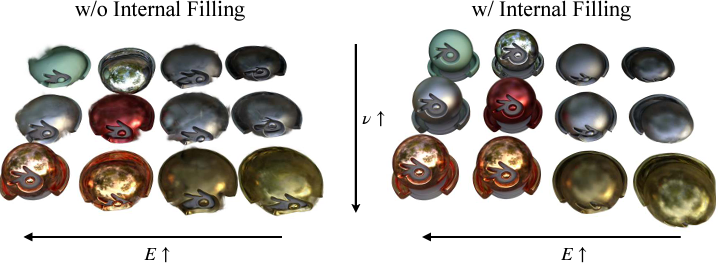
E는 elasticity(탄성도), v는 poission ratio(volume 보존 정도)

당겼을 때 Physics-based Ours는 물리 법칙에 따라 volume을 잘 보존하지만, Geometry-based NeRF-Editing은 volume 보존하지 않음
Conclusion
- Limitation :
- 그림자 고려 안 함
- material param.를 manually 정해주어야 함
(GS segmentation과 differentiable MPM simulator를 결합하여 video로부터 param. 자동 assign 가능하긴 함)
- Future Work :
- more versatile materials like liquid 다루기
- more intuitive user control 포함하기
- LLM 기술 적용하기
- geometry-aware 3DGS recon. 결합하여 generative dynamics (생성 동역학) 향상시키기
- 마무리하며..
3DGS와 전혀 다른 분야를 통합하는 논문들이 종종 나오는데
이 논문도 결과가 재미있게 나온 논문이었다!!